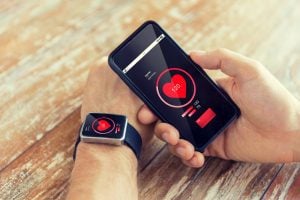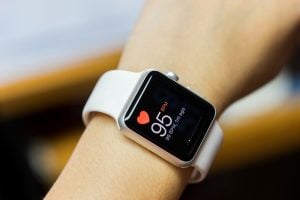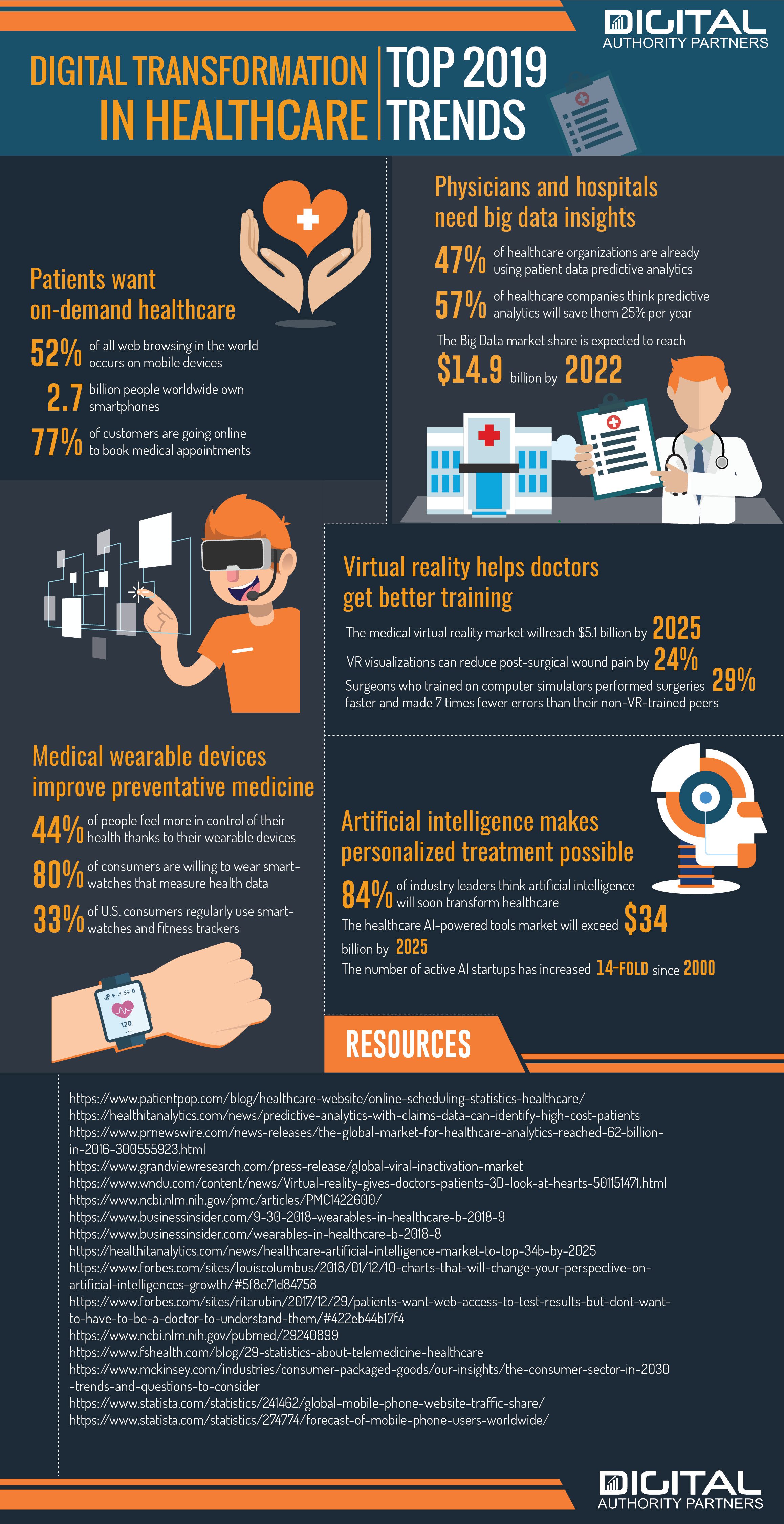As a healthcare business, you probably know that keeping up with digital transformation in healthcare can feel overwhelming.
Deciding which emerging technologies are worth investing in and getting your team on board with change is often the hardest part. Plus, adapting to the digital era requires a shift towards a flexible and risk-taking mindset. It means letting go of outdated business processes and trusting that disruption will yield big results. Before we dive deeper into this topic, a quick recap.
Digital transformation in healthcare is a broad and fairly new concept that can be best described as the positive impact of technology in healthcare. Telemedicine, artificial intelligence (AI)-enabled medical devices, and blockchain electronic health records are just a few concrete examples of digital transformation in healthcare. Innovation is the name of the game here, with the main goal of streamlining physicians’ work, optimizing systems, improving patient outcomes, reducing human error, and lowering costs.
Unfortunately, the healthcare and pharmaceutical industries have lagged behind when it comes to implementing digital strategies. In fact, in a recent survey, only seven percent of healthcare and pharmaceutical companies said they had gone digital, compared to 15 percent of companies in other industries.
Despite that, the U.S. healthcare market is enormous; with the national health spending projected to reach $5.7 trillion by 2026. There’s still time for you to get well-versed in digital technology and use it to bring in more business. But in order to transform your standard practice into a thriving, digital machine in 2019, you first need a comprehensive picture of the modern healthcare landscape.
Thanks to technology, patients get better treatment with virtual reality tools, wearable medical devices, telehealth, and 5G mobile technology. Doctors, on the other hand, can streamline their workflows using artificial intelligence-powered systems.
Here’s a better look at the state of digital transformation in healthcare in 2019:
The rise of on-demand healthcare (why patients want healthcare on their own schedule)
When you think of ‘on-demand,’ you think of consumers who want things at their own convenience, on their own time, and wherever they happen to be. The healthcare industry is entering the era of digital innovation, as patients seek on-demand healthcare because of their busy schedules. Mobile is especially important when considering content marketing.
People have simply become far more mobile in the past decade. Mobility is the name of the game, and recent statistics show that more than 50% of all web browsing in the world occurs on mobile devices as of 2018 (to be exact, 52%).
One of the first rules of content marketing is that you must identify where your targeted consumers gather and reach them on those platforms, i.e. mobile. That’s not surprising given that 77 percent of U.S. residents own a smartphone. On top of that, the number of mobile phone users in the world is expected to pass the five billion mark by 2019.
Factor in that more than four billion people globally are on the Internet and you can start to see the possibilities that digital transformation in healthcare offer.

According to DMN3, consumers are going online to obtain medical information for the following reasons:
- 47% research doctors
- 38% research hospital and medical facilities
- 77% book medical appointments
But on-demand healthcare is also driven by the growth of the ‘gig’ economy, in which freelance professionals in various industries hire themselves out per job or ‘gig,’ instead of tethering themselves to one company.
Companies such as Nomad Health – an online marketplace that links doctors directly with medical facilities for short-term work – are making it easier for physicians to provide on-demand healthcare to clients in specific circumstances that match their talents, expertise, and schedule. In other words, doctors themselves become on-demand healthcare providers to better meet the changing needs of their patients, another benefit of digital transformation in the healthcare industry.
The importance of big data in healthcare
Big data aggregates information about a business through formats such as social media, ecommerce, online transactions, and financial transactions, and identifies patterns and trends for future use.
For the healthcare industry, big data can provide several important benefits, including:
- Lower rate of medication errors – through patient record analysis, software can flag any inconsistencies between a patient’s health and drug prescriptions, alerting health professionals and patients when there is a potential risk of a medication error.
- Facilitating Preventive Care – a high volume of people stepping into emergency rooms are recurring patients also called “frequent flyers.” They can account for up to 28% of visits. Big data analysis could identify these people and create preventive plans to keep them from returning.
- More Accurate Staffing – big data’s predictive analysis could help hospitals and clinics estimate future admission rates, which helps these facilities allocate the proper staff to deal with patients. This saves money and reduces emergency room wait times when a facility is understaffed.

With these benefits in mind, healthcare and pharmaceutical companies should invest in organizing their data. That requires an investment in analytics experts who can crunch the data to not only identify areas of weakness, but to also help companies better understand their market.
For example, if you’re in the pharmaceutical industry, you probably understand that marketing dynamics are constantly shifting. In fact, drugmakers believe that the biggest advantage of big data is how it helps them understand the market. And with that understanding, they can determine product iteration and product budgets based on existing and future demand.
With a better grasp of the market, your healthcare marketing and sales teams will have an easier time identifying your ideal consumer. And a big part of that is creating a customer persona, which compiles demographic information on what your prospects want and need, and the platforms where you can reach them.
Treating patients with virtual reality
Ten years ago, telling people you could reduce their pain with a device similar to a video game would have garnered a lot of blank stares. In 2018, however, Virtual Reality (VR) is the pièce de résistance of digital transformation in healthcare. Its myriad of applications are profoundly changing the way patients are being treated.
Take pain management for instance. Up until recently, doctors were handing out opioids prescriptions like candy. Migraines? Postoperative pain? Here’s some OxyContin, Vicodin, or Percocet. As a result, the country is currently facing the worst drug crisis in American history, representing an economic burden of $78.5 billion a year.
Here’s the thing: millions of people are still struggling with chronic pain. According to the CDC, 50 million of U.S. adults had chronic pain in 2016. For them, VR is a safer, more efficient alternative to drugs. VR technology is being used not only to treat pain, but everything from anxiety to post-traumatic stress disorder, and stroke.
And that’s just a fraction of VR’s proven capabilities in the medical field. Other uses include, doctors and residents using virtual-reality simulations to hone their skills or to plan complicated surgeries. VR headsets could also motivate wearers to exercise and help children with autism learn how to navigate the world.
From startups to pharma giants, everyone is betting on VR and there are numbers to back them up. The global virtual and augmented reality in healthcare market is expected to reach $5.1 billion by 2025. If you’re a healthcare company planning your digital marketing strategy, you should highly consider investing this technology.
VR is a powerful communication channel that would allow you, among other things, to get a better sense of your customers’ needs and virtually engage them with your products or services.
The growth of wearable medical devices
Another trend of the digital transformation in healthcare is companies collecting their own health data from medical devices, including wearable technology.
In the past, most patients were satisfied with undergoing a physical once a year, and only checking in with their doctors when something went wrong. But in the digital age, patients are focusing on prevention and maintenance, and demanding information about their health more frequently.
As a result, healthcare companies are being proactive by investing in wearable technology devices that can provide up-to-date monitoring of high-risk patients to determine the likelihood of a major health event. According to a recent report, the wearable medical device market is expected to reach more than $27 million by 2023, a spectacular jump from almost $8 million in 2017.
Some of the most common of these devices include:
- Heart rate sensors
- Exercise trackers
- Sweat meters – used for diabetics to monitor blood sugar levels.
- Oximeters – monitors the amount of oxygen carried in the blood, and is often used by patients with respiratory illnesses such as COPD or asthma.

Other benefits for healthcare companies who invest in these products:
- Personalizes the healthcare experience – medical devices give patients a sense of ownership in the process of improving their health.
- Targets insurance pricing – information obtained from wearable devices can help insurers more accurately rate a patient’s risk for illness.
- Provides insurance incentives – patients who take preventive measures to improve their health can obtain lower insurance premiums.
- Provides gamification opportunities – some medical devices such as fitness watches can create competitive goals for users to achieve through exercise, diet and nutrition.
Furthermore, wearable technology can also help healthcare companies save money. One study found that health apps and wearables for preventative care could save the U.S. healthcare system close to $7 billion per year.
Predictive healthcare
Earlier, we touched on how big data could provide healthcare companies with predictive analysis about admission rates and help them properly staff their facilities. But another factor supporting the digital transformation in healthcare is predicting what illnesses and diseases will become major problems in the near future.
Information aggregated through Big Data and other marketing sources can help healthcare companies develop healthy lifestyle recommendations for their patients.
For example, you could hire an analyst to analyze keyword activity across social media channels and on major search engines to determine the most common searches for medical conditions, illnesses, and general health. The analyst could then develop a predictive model that would anticipate where and when the next big health scare will occur, and how your company can prepare for that event.
But on a smaller scale, predictive analysis could help businesses of all sizes determine when to hire temporary staff due to impending outbreaks of colds and flu that could result in a worker shortage.

The wonders of artificial intelligence
Artificial intelligence (AI) is more than just a digital transformation trend in healthcare. AI represents the epitome of medical innovation and industry players are eager to invest millions in it. The healthcare AI-powered tools market is expected to exceed $34 billion by 2025, which means this technology will shape almost all facets of the industry.
For most patients, AI in medicine brings to mind Japanese nurse robots. But now, there are plenty of American versions too, like Moxi, a friendly hospital droid designed to assist human nurses with routine tasks such as fetching and restocking supplies.
Chatbots and virtual health assistants are another AI-based technology that patients are becoming familiar with. Chatbots can fill a multitude of roles from customer service representatives to diagnostic tools and even therapists. Their versatility is being translated in heavy investments. The global healthcare chatbots market is projected to reach $314.3 million by 2023 from $122 million in 2018.
But the real power of AI can be best observed in areas like precision medicine, medical imaging, drug discovery, and genomics. For instance, cancer patients used to receive cookie-cutter treatments with high failure rates. Now, thanks to AI’s sophisticated pattern recognition, these patients have access to personalized therapies tailored to their genetic makeup and lifestyle.
What AI-powered computer programs do for oncology, in a nutshell, is analyze thousands of pathology images of various cancers to provide highly accurate diagnoses and predict the best possible anti-cancer drug combinations. And, in medical imaging diagnostics, this technology helps radiologists spot details that escape the human eye.
What’s more, top pharmaceutical and biotechnology companies are using machine learning algorithms to shorten the drug development cycle. In fact, recent findings show that AI can slash early drug discovery timelines by four years against the industry average, and generate cost savings of 60 percent.
Overall, AI is predicted to bring $150 billion dollars in annual savings for the US healthcare economy by 2026. Startups are already jumping on this opportunity; the number of active AI startups has increased 14-fold since 2000.
These numbers alone should be enough to convince any CEO looking to usher their health organization into reaching digital maturity that AI is worth the investment.
Blockchain and the promise of better electronic health records
Blockchain has recently developed a bad reputation due to the burst of the cryptocurrency bubble. Now, the average person thinks of blockchain as of this vague, puzzling concept that doesn’t have much of an impact on their life. In reality, this technology will soon play an instrumental role in keeping their electronic health records accurate and safe.
Blockchain is a digital ledger or a computerized database of transactions. Shared across a network of computers, it allows customers to safely exchange financial information with suppliers, without the need of a third party such as a bank.
The healthcare and pharmaceutical industries are already vouching for its efficiency by investing millions in this market. According to a recent report, blockchain in healthcare market is expected to reach$890.5 million by 2023.

In healthcare, blockchain is proven to be an effective tool in preventing data breaches, improving the accuracy of medical records, and cutting costs.
For years, health officials and experts have been trying to come up with doable solutions to the problem of fragmented medical records.
An electronic health record (EHR) is basically the digital version of a medical chart and includes everything from a patient’s medical history and diagnoses, to treatment plans, immunization dates, and test results. It also contains their home address, previous workplaces, as well as financial information like credit card numbers. This is what makes EHRs such an appealing target for hackers, who are selling them for up to $1,000 on the black market.
Yet, for as valuable as they are, hospitals are falling short in managing their EHRs.
Medical data is currently being recorded in unstructured formats and stretched across multiple EHR systems. Already short-staffed doctors and nurses struggle to manually log in every piece of information. This leads to huge errors such as duplicate medical records, misdiagnoses, delayed treatments, and even deaths.
Some countries like Australia and UK have started to experiment with blockchain technology to manage medical records and transactions among patients, healthcare providers, and insurance companies. Thanks to a decentralised network of computers that handle the blockchain and simultaneously register every transaction, conflicting information is automatically detected. Records are not only 100% accurate, but also harder to hack.
In the U.S., regulations make it harder for companies to create blockchain-based EHRs. Some startups like Medicalchain, however, are making big strides towards a future where patients will control their EHRs from an app, where doctors, pharmacists, or health insurers will be requesting permission to access their data and where all transactions will be recorded on the distributed ledger.
Health in the palm of your hand
The healthcare system is undergoing a seismic shift in how information is obtained and disseminated. Gone are the days when all medical information was under the lock and key of doctors and surgeons, and patients had to sign away their lives to access their own health information – consumers want to be able to access all aspects of their health record and do so from the palm of their hand.
Through tools such as online patient portals that provide medical test results, diagnosis, and explanations of illnesses, patients are now becoming participants in their well being.
And that allows doctors to analyze patients in real-time.
What does it really mean when your FitBit says you’ve completed 14,000 steps in a day? By itself, that is just information. It becomes valuable when doctors and medical analysts transform that this data into actionable knowledge about how those steps helped you burn a specific number of calories, and that increasing those steps will help you maintain your ideal weight. While digital technology is a valuable tool in healthcare, it’s important to remember that it is still just a tool that you can add in your repertoire.
5G mobile technology for instantaneous healthcare
Speaking of health in the palm of your health or in your pocket…As wireless technology gets more sophisticated, so does the delivery of medicine.
Introduced by Qualcomm, the world’s largest mobile chipset supplier, 5G enhanced Mobile BroadBand (eMBB) is considered to be the driver of the new mobile industry revolution.
The technology can run up to 100 times faster than the current cellular connection, which made industry experts confident that it will completely change the healthcare landscape and lead to savings of up to $650 billion by 2025.
Here’s how.
First, Qualcomm says 5G will make “buffering” a thing of the past, allowing for instantaneous streaming, downloading, and uploading. For telemedicine, this means patients will experience better video conference quality, regardless of location. More importantly, doctors will have access to accurate, real-time imaging of organs, soft tissue, and bones, which in turn will greatly decrease the risk of misdiagnosis.
With the current network bandwidth, it takes hours for doctors to send large imaging files to a specialist. Once health facilities will switch to 5G networks, the transmission process will take just a couple of minutes.
And that’s not even a fraction of how 5G could transform healthcare.
“5G is designed to pair with technologies like artificial intelligence and XR to enhance current services and applications, offering a different level of user experiences,” says Qualcomm.
Let’s take a look at some practical examples:
- Clinicians could soon use ultra-reliable connections to teleport to virtual environments and perform robotic surgeries.
- Augmented reality (AR) glasses would allow first responders to connect with faraway specialists and “show” them exactly what they are seeing, in order to receive better guidance.
- 5G could also support medical training, enabling students to use virtual reality headsets to practice at their own pace the steps of complex surgeries.
- 5G-enabled drones could deliver life-saving medicine or devices to patients in hard-to-reach rural areas. A university in Sweden is already testing these drones to deliver defibrillators to cardiac arrest victims.
But it is in the wearable medical device market where 5G will cause the greatest disruption. Remote monitoring technology has yet to reach its full potential due slow network speeds and unreliable connections. With 5G, clinicians will be able to instantaneously collect medical data such as a vitals or physical activity levels from disparate sources and large groups of patients and make fast,reliable diagnoses.
This is preventative care at its best: less people developing chronic conditions and less money spent caring for patients in hospitals or in emergency rooms. All in all, 5G is guaranteed to play a major role in healthcare this year and patients will be the first ones to feel the positive changes. The first 5G data cards will be launched by spring and 5G smartphones will hit the market within the first half of 2019.
The state of digital transformation in healthcare in 2019 looks quite promising, doesn’t it?
As with any business, the goal is to create products and services that improve lives or fulfill a want or need. Technology can help you realize this goal. Use this guide as a compass to navigate your way through the digital healthcare space and to build transformative experiences – with the client at the center of everything you do.
